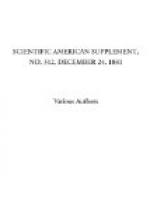In 1881, blast furnaces are from 90 ft. to 100 ft. high, and 25 ft. in diameter at the boshes; they turn out from 500 to 800 tons a week. The tops and also the hearths are closed, and the blast—thanks to the use of Mr. E.A. Cowper’s stoves—is at 1,200 degrees. The manufacture of iron has also now enlisted in its service the chemist as well as the engineer, and among those who have done much for the improvement of the blast furnaces, to no one is greater praise due than to Mr. Isaac Lowthian Bell, who has brought the manufacture of iron to the position of a highly scientific operation. In the production of wrought iron by the puddling process, and in the subsequent mill operations, there is no very considerable change, except in the magnitude of the machines employed, and, in the greater rapidity with which they now run. In saying this, I am not forgetting the various “mechanical puddlers” which have been put to work, nor the attempts that have been made by the use of some of them to make wrought iron direct from the ore; but neither the “mechanical puddler” nor the “direct process” has yet come into general use; and I desire to be taken as speaking of that which is the ordinary process pursued at the present in puddled iron manufactures. In 1831, a few hundredweights was the limit of weight of a plate, while in 1881, there may readily be obtained, for boiler-making purposes, plates of at least four times the weight of those that were made in 1831. I may, perhaps, be allowed to say that there is an extremely interesting blue-book of the year 1818, containing the report of a parliamentary committee which sat on boiler explosions, and I recommend any mechanical engineer who is interested in the history of the subject to read that book; he will find it there stated that in the North of England there was a species of engines called locomotives, the boilers of which were made of wrought iron, beaten, not rolled, because the rolled plate was not considered fit; it was added that if made of beaten iron the boiler would last at least a year.
In 1831, thirteen years later, the dimensions of rolled plates were no doubt raised; but few then would have supposed it possible there should be rolled such plates as are now produced for boiler purposes, and still fewer would have believed that in the year 1881 we should make, for warlike purposes, rolled plates 22 inches in thickness and 30 tons in weight. I have said there is very little alteration in the process of making wrought iron by puddling, and I do not think there is likely to be much further, if any, improvement in this process, because I believe that, with certain exceptions, the manufacture of iron by puddling is a doomed industry. I ventured to say, in a lecture I delivered at the Royal Institution three years ago on “The Future of Steel,” that I believed puddled iron, except for the mere hand wrought forge purposes of the country blacksmith, and for such like purposes, would soon become a thing of the past.




